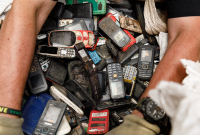Support strong Canadian climate journalism for 2025
Refrigerators used to last decades — think of your grandparent’s blue Frigidaire, with your parent’s fifth birthday cake inside, and later, yours. Now, you’re lucky if any of your appliances make it a decade — a problem that a new report says could be aided with a mandatory rating system.
Released Tuesday, the report by Équiterre says Canada should create a mandatory durability index and enshrine it into legislation. The index would assign grades to appliances, making it clear how easy they are to repair and what their expected lifespans are. That way, companies would be held accountable for the longevity of their products and consumers would be able to make informed decisions about their purchases.
“It doesn't make sense that today, even though we have technological progress, we don't manufacture more durable goods,” explained Amélie Côté, a spokesperson for the non-profit.
“We know we are able to do it. We could have an equivalent of our grandmother's fridge that lasted 60 years and make it energy efficient. And that would be the best combination of solutions.”
A durability index for appliances, from fridges to laptops, would be reminiscent of the Energy Star ratings that are accessible today, which grade products on their energy efficiency. The report recommends that an independent body create the rating system, which would measure the durability of the appliance on a scale of one to ten and include additional information on reliability, repairability and how easy the product is to upgrade.

This would be a big shift, notes Côté, who points to a previous study by Équiterre that found appliances typically break an average of 2.6 years after purchase. Appliances that break down prematurely have a negative impact on people’s pocketbooks and the environment.
“What we know about home appliances and electronics is that the main environmental impact is linked to the manufacturing. Like for a cell phone, it's 600 times the weight in natural resources needed to manufacture one,” she said.
The recommendation from Équiterre follows the example of France, which has required a repairability index for some appliances and electronics since 2021. In 2025, they will expand their current system to include a durability index for televisions and washing machines. While the index would need to be tailored to fit the Canadian context, France shows that it’s possible and effective, said Côté.
“There is a recent French study that showed an increase in the sale of products that are more repairable. So we see that it really influences the purchasing decision, and it becomes a vector of competition between manufacturers because they want to have a better rating,” she said.
That competition seemingly leads to better products, as data also show the average repairability index score increasing, Côté adds.
The Right to Repair
A durability index fits into the broader conversation about the right to repair, a legal concept that requires consumers to be able to repair their devices, rather than having to replace them. The Canadian government is currently in the consultation phase of its right-to-repair legislation. Budget 2024 specifically mentions the concept of a durability index, and notes that the federal government is currently exploring “the merits of a durability index which could help Canadians better understand how long their device is expected to last.”
A study from the University of Waterloo found that Canadians generated close to one million tonnes of e-waste in 2020 and that the amount of e-waste (which includes everything from cellphones to home appliances) climbed from 8.3 kilograms in 2000 to 25.3 kilos in 2020, with the expectation it will continue to rise.
That waste is connected to how difficult and expensive it currently is to get appliances fixed: you often have to go to the company that created them because of exclusive software and other barriers that companies put in place. Often, buying a new product is cheaper than fixing it.
It’s a concept often referred to as planned obsolescence: companies sell products that they know will quickly break or deteriorate, forcing consumers to buy a new one, Alissa Centivany, assistant professor at the Faculty of Information and Media Studies at Western University, told Canada’s National Observer in 2023.
“We need to find ways to shift manufacturers away from planned obsolescence and create incentives and requirements for ensuring the products they make are more durable,” she said at the time.
“Replacing a smartphone every two years and a laptop every four years is simply not sustainable. We need to move beyond a ‘profit-at-all-cost’ mindset and recognize that reparability feeds important values like growth and innovation.”
Right-to-repair legislation, along with the durability index, would take power away from companies who have left consumers in the dark for too long, said Côté.
“It’s already being done in other countries, and Canadians are ready for it. It would be good for our budgets, our local economies, our small and medium-sized repair businesses and the environment. So what are we waiting for?”






Comments
My wife and I have been married 49 years and in that time we never had to buy or repair a refrigerator, with the exception of a new fridge as a result of a move or renovation. Even then, the fridges were left behind or sold in good working condition. In 2021 we had our kitchen redone and bought new appliances to replace the 20+ year old existing models. In August, our LG fridge, not quite 3 years old, stopped cooling due to compressor failure. Of course, it was not repairable so we got a replacement fridge, a Frigidaire Gallery, through our extended warranty. After installation, we found that both the freezer and fridge doors made very loud creaking/thunking nosies when opened or closed. We were able to return the fridge to Home Depot (within 48 hours of delivery) and got an identical model (thinking previous fridge was a lemon) only to find it had the same problem with the doors. Back to Home Depot. Now we have a Whirlpool, which one month in is making loud noises every time the condenser fan comes on to cool the compressor. I doubt that this fridge is long for the world. So, since August we are on our 4th fridge. Extended warranties are essential. The government needs to fast track legislation to protect consumers and the environment from the conspiracy by major appliance companies to design products that prematurely fail.
Similar issues, new built in oven lasted 30 days before computer panel packed it in. No parts available. Back to Home Depot. Different brand, 6 months. Now the one we kept doesn't accurately keep temperatures so bought an old stove with oven and installed in garage which keeps temperatures and wife uses regular.
2 year dishwasher at $1500 gets a food piece stuck in water feed to upper rack. Less expensive to purchase Sears Kenmore for $299 than fix it. Sold my house in Prince George 2o years ago with 25 uear old Maytag washer and dryer. Still working I have heard.
Neighbour's at cottage in Manitoba each had fridge from the 30 and from the 40, still working.
I have written to the Federal Government ministries responsible for this subject. Crickets. Nothing heard back. Canada is studying what works in France. Why? Just adopt as a starting point, and let's get on with it. Getting industry feedback? I will paraphrase their position: we don't want it because (unspoken) it will decrease profits on our cheaply made "stuff". We are killing our planet with our extractive economy. We must adapt/change or die.